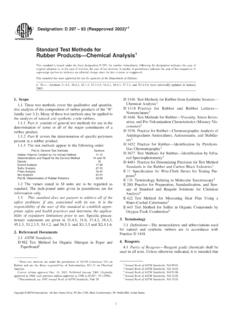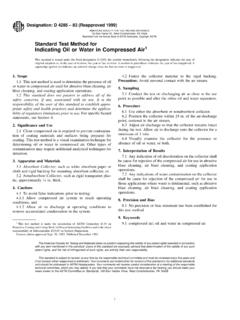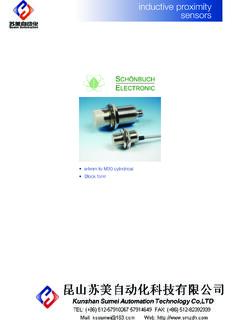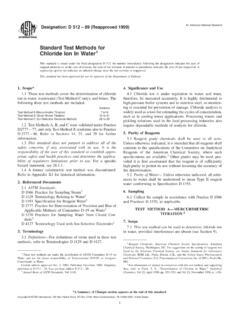Transcription of Standard Test Method for Tensile Strength and Elongation ...
1 Designation: D 3759/D 3759M 04 Standard Test Method forTensile Strength and Elongation of Pressure-SensitiveTapes1 This Standard is issued under the fixed designation D 3759/D 3759M; the number immediately following the designation indicates theyear of original adoption or, in the case of revision, the year of last revision. A number in parentheses indicates the year of lastreapproval. A superscript epsilon (e) indicates an editorial change since the last revision or This test Method covers the measurement of tensilestrength (breaking Strength ) and stretch properties (elongationand F value) for pressure-sensitive tapes. It includes proce-dures for machine direction cross-direction tests and tests fortapes with low and high stretch and reinforced backings.
2 It alsoincludes a procedure for obtaining stretch force ( F value) inconjunction with a determination of Tensile Strength . Theseprocedures employ a constant-rate-of-extension (CRE)-typetesting machine. They apply to the principle of stretching thespecimen at a fixed strain rate of 25 mm per 25 mm [1 in. perinch] of specimen length per minute with the exception of theprocedure for reinforced The values stated in either SI or inch-pound units are tobe regarded separately as Standard . The values stated in eachsystem may not be exact equivalents; therefore, each systemmust be used independently, without combining values in Standard does not purport to address all of thesafety concerns, if any, associated with its use.
3 It is theresponsibility of the user of this Standard to establish appro-priate safety and health practices and determine the applica-bility of regulatory limitations prior to Referenced Standards:2D 828 Test Method for Tensile Properties of Paper andPaperboard Using Constant-Rate-of- Elongation ApparatusD 882 Test Method for Tensile Properties of Thin PlasticSheetingD 996 Terminology of Packaging and Distribution Environ-mentsD 3715 Practice for Quality Assurance of Pressure-Sensitive TapesD 4332 Practice for Conditioning Containers, Packages, orPackaging Components for TestingE 4 Practices for Force Verification of Testing MachinesE 122 Practice for Choice of Sample Size to Estimate aMeasure of Quality for a Lot or Process3.
4 Terminology found in Terminology D 996 shall Significance and This test Method provides information that can be usedin material specifications for product design and qualityassurance applications. It can be used in comparing The use of this test Method must be related to thepurpose for which the test is performed. One purpose is fordetermining the relative Strength of the tape in the size in whichit is purchased or used. Another purpose is to identify orcharacterize a particular backing When relative Strength is of interest, the test may beperformed on the tape as-received, that is, without cutting thematerial to a specimen width less than the as-received Usually tapes wider than 48 mm [2 in.]
5 ] are not testeddue principally to the limitations of equipment. Tapes asnarrow as approximately 3 mm [ in.] can be Comparison of materials by different test methodsshould be avoided because the test parameters of specimendimensions and cross head velocity determine the in the parameter levels will produce different resultsfor the same It is usual to find the Tensile Strength increasing significantlywith increasing cross head velocity and, therefore, strain When identity or material characterization is of inter-est, the test should be performed on a specimen cut from withinthe sample material boundaries using a sharp razor cutter, suchas that defined in Section Some of the traditional tools for specimen preparation mustbe avoided when the backing is comprised of thin plastic sheeting.
6 Theseinclude chopping dies and sample cutters operating on a shearingprinciple. The reason for this restraint is that edges sufficiently ragged anddamaged resulting from chopping or shearing cause tearing to occurbefore the true Tensile Strength level is reached. Tapes with fibrousbackings may be cut to satisfactory specimens with these test Method is under the jurisdiction of ASTM Committee D10 onPackaging and is the direct responsibility of Subcommittee on Tape edition approved April 1, 2004. Published May 2004. Originallyapproved in 1983. Last previous edition approved in 1996 as D 3759 referenced ASTM standards, visit the ASTM website, , orcontact ASTM Customer Service at ForAnnual Book of ASTMS tandardsvolume information, refer to the Standard s Document Summary page onthe ASTM ASTM International, 100 Barr Harbor Drive, PO Box C700, West Conshohocken, PA 19428-2959, United Stretch characteristics can be related to the tape sintended use or for identifying or characterizing a Elongation measurements become difficult to perform onstretchy materials (greater than 25 % ultimate Elongation ) when the ratioof specimen length to width is small (approaching 2).
7 The results showhigh variability and do not allow for practical use of this informationexcept when one wishes to demonstrate large differences between Tester A constant-rate-of-extension (CRE)type with load cell capacity such that the maximum expectedspecimen Strength does not exceed 90 % of its normal The Tensile testing machine must be equipped with ameasurement system which records the force and deformation( Elongation ) of the test specimen during the test. This may bea pen and stylus, digital output, microprocessor, or computerbased system. The accuracy shall be verified in accordancewith Practice E 4 or (Optional) A suitable instrument, ifdesired, may be used for determining the distance between twodesignated points of the test specimen as the specimen (Optional) A suitable instrument, micro-processor, or software analysis system may be used fordetermining the energy or work required to break the , preferably the pneumatic action Clamp faces at least 50 mm [2 in.]
8 ] wide by 38 mm[11 2in.] deep. Faces shall have a light cross-hatch Plastic materials are reduced in width and thickness whilebeing stretched. This causes them to be drawn out of the clamps minimize this effect. It can be further reduced by theappropriate choice of surface of the clamps. The greatest improvement,both with respect to the above mentioned shrinkage problem and simpleslippage, may be found from the use of urethane film which can beobtained as a pressure-sensitive tape approximately 20 mils thick. Thismaterial has a very high coefficient of friction, is somewhat malleable, andis easily replaced. Alternative materials are coated abrasive, rubber(neoprene or other synthetic type), or other , in place of clamps for testing reinforcedtapes.
9 Each of two cylinders shall be 100 mm [4 in.] indiameter by 38 mm [ in.] thick held in the positionordinarily occupied by the clamps so that the tape, whenapplied to the cylinders and extending between them, falls inthe fine of stress otherwise occupied by the specimens whenclamps are used. See Fig. , approximately 22 mm [1 in.] in length dividedinto 2-mm [ ] increments attached to each cylinder. Thezero point or (origin) shall be at the point of tangency of thetape with the cylinder during the test and the scale shallincrease upward on the lower cylinder and downward on theupper These scales will be used to observe and measure the tapeslippage during the tension test for reinforced ,3holding two single-edged razor blades in paral-lel planes, a precise distance apart, to form a cutter of exactspecimen width.
10 Appropriate widths shall be available (refer tospecimen width in Table 1) patterned after the 12 mm [1 2-in.]cutter in The differences between cutters of variouswidths is in the final width of the bar after removing thethickness of one razor from Chemsultants International, 9349 Hamilton Dr., Mentor, 1 Test Configuration for Reinforced TapesTABLE 1 Test Preparation and Specimen DimensionsGage Length,mm [in.]Cross Head Velocity,mm [in.]/minSpecimen Width,Amm [in.]Length,mm [in.]Machine DirectionElongation under 150 %125 [5]125 [5]12-24 [ ]225 [9] Elongation over 150 %50 [2]50 [2]12 [ ]150 [6]Reinforced Tapes250 [10]125 [5]12-24 [ ]700 [28]Cross DirectionB,C,D25 [1]25 [1]12 [ ]125 [5]AThe specimen widths shown are for tests in which the specimen is cut from within the sample dimension.










